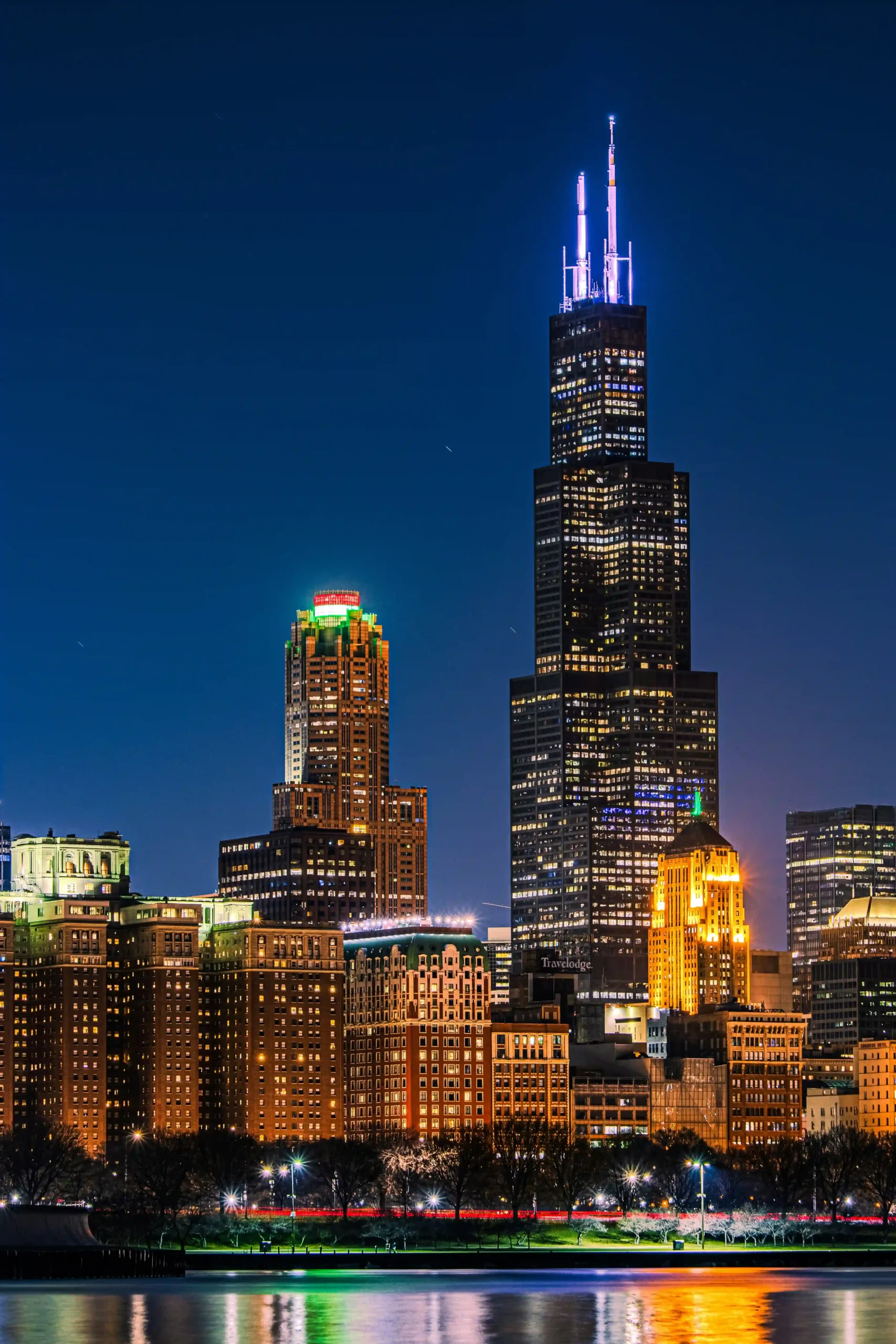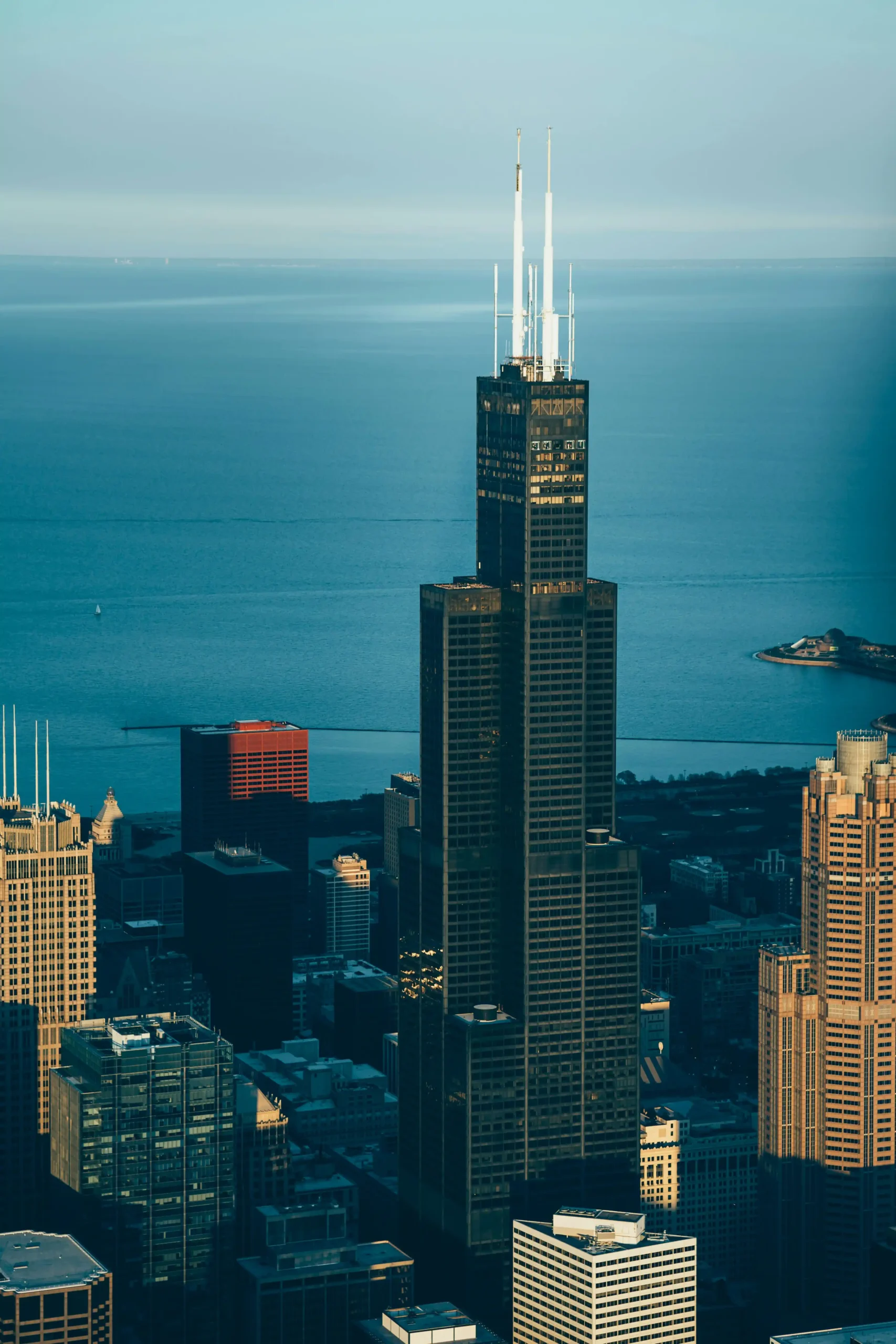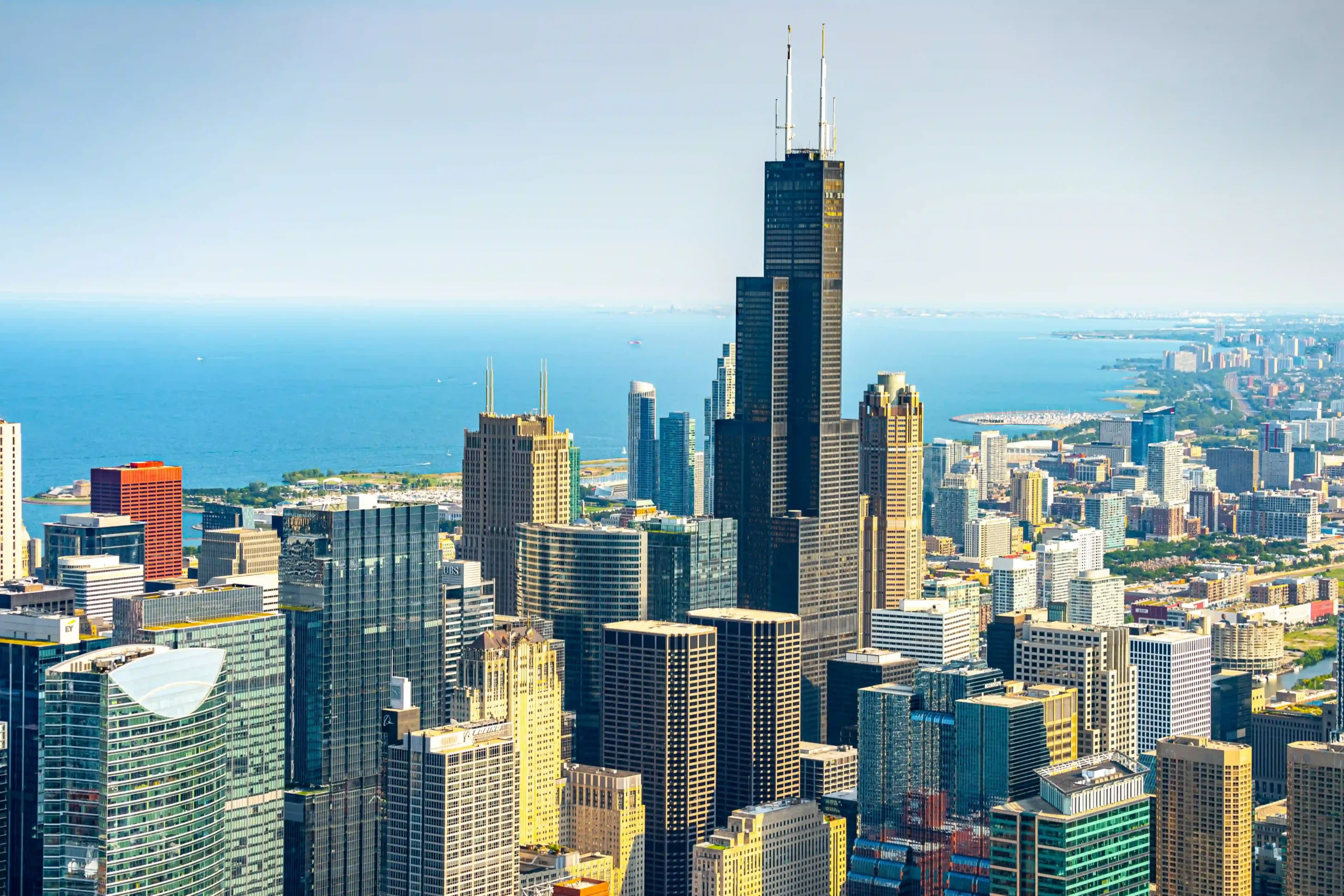Rising 442 metres (1,451 ft) above the bustling streets of Chicago, the Willis Tower — formerly known as the Sears Tower — stands as one of the most enduring symbols of American architecture. Completed in 1973, it surpassed the original World Trade Center Twin Towers to become the tallest building in the world, a record it held for 25 years before being surpassed by the Petronas Towers in Kuala Lumpur, Malaysia. The tower was the first building to utilize the revolutionary bundled tube design, consisting of nine distinct square tubes clustered together, which rose to varying heights to create its distinctive stepped profile. This design, pioneered by architect Bruce Graham and engineer Fazlur Rahman Khan, set new benchmarks for skyscraper engineering and shaped the future of tall building design worldwide.
Tower Stats
- Height: 442 m / 1,450 ft to roof (527 m / 1,729 ft to tip; antennas are not considered part of the building’s official height)
- Floors: 110
- World Ranking (August 2025): 25th tallest building in the world
- Total Floor Area: Approximately 420,000 m² / 4.5 million ft² (3rd largest skyscraper in the world by floor area)
- Number of Elevators: 104
- Construction Period: 1970–1973
- Construction Cost: US $150 million (about $1 billion today)
- Location: 233 South Wacker Drive, Chicago, Illinois, USA
- Primary Use: Commercial office space, observation deck, retail, and public attractions
- Notable Facilities: Skydeck observation deck on the 103rd floor, The Ledge glass balconies, retail and dining spaces in the lower floors, fitness and conference facilities for tenants
Architecture and Design
The Willis Tower was designed by the architectural firm Skidmore, Owings & Merrill, with Bruce Graham serving as chief architect and Fazlur Rahman Khan as chief structural engineer. Its revolutionary bundled tube design consists of nine square tubes clustered together rising to different heights, creating the building’s distinctive stepped profile. This innovative design gave the tower exceptional strength and stability while using materials efficiently, enabling it to reach record-breaking heights for its time.
The exterior is clad in black aluminum and bronze-tinted glass. Inside, vast open floor plates provide flexible office space, accommodating tenants ranging from corporate headquarters to law firms and tech companies. The building’s design has proven both functional and iconic, maintaining its relevance for more than five decades.
The Willis Tower is currently undergoing one of the most extensive renovation projects in Chicago’s history, with a budget exceeding $500 million. This ambitious overhaul aims to modernize nearly every aspect of the building, from its energy systems and HVAC upgrades to transforming public areas and tenant amenities. The renovation includes the installation of cutting-edge, energy-efficient technologies, redesigned lobbies and retail spaces, expanded dining and fitness facilities, and improvements to accessibility and sustainability.



Photos by: Gael D on Unsplash, Ricky Esquivel snd Dominik Gryzbon on Pexels
Hospitality & Amenities
While primarily an office building, the Willis Tower offers a variety of public spaces and amenities. The most famous is Skydeck Chicago, located on the 103rd floor, which draws more than 1.5 million visitors annually. The highlight is The Ledge—a series of glass-floored balconies extending outside the building, allowing visitors to stand suspended above the city streets. This observation deck is the highest publicly accessible one in the United States, surpassing the One World Trade Center by nearly 30 metres.
Other amenities include conference facilities, dining options, and retail spaces. Recent renovations have transformed the lower levels into a vibrant mixed-use space known as Catalog at Willis Tower, featuring restaurants, cafes, and shops. Tenants enjoy fitness facilities, tenant lounges, and updated workspaces with panoramic city views.
Naming Rights History
Originally named the Sears Tower after its primary tenant, Sears, Roebuck & Co., the building carried this name for more than 35 years. In 2009, the England-based insurance broker Willis Group Holdings leased a portion of the building and acquired the naming rights, renaming it Willis Tower. Despite this official change, many Chicagoans and visitors continue to refer to it as the Sears Tower, reflecting its deep cultural roots.
Tourism Magnet
The Willis Tower’s Skydeck is one of Chicago’s most popular tourist attractions. From this vantage point, visitors can see up to 50 miles on a clear day, spanning four states—Illinois, Indiana, Wisconsin, and Michigan. Interactive exhibits share the history of the building, the city’s skyline, and the engineering feats that made the structure possible.
The Ledge has become a must-visit experience for thrill-seekers and photographers alike, offering an unmatched view of the sprawling metropolis below.

Economic Ripple Effect
As one of the most recognizable buildings in the United States, the Willis Tower plays a vital role in Chicago’s economy. It houses more than 100 companies, accommodates roughly 12,000 occupants, and attracts millions in tourism revenue each year. Its presence reinforces Chicago’s status as a global business and cultural hub, encouraging investment and development in the surrounding Loop district.
Engineering and Construction Challenges
Foundation and Structure
The bundled-tube design pioneered by Fazlur Khan was a groundbreaking approach, allowing the tower to resist strong winds while using less steel than a traditional frame. Each of the nine tubes functions as a separate building, connected for strength and stability.
Wind and Seismic Resistance
The tower’s aerodynamic profile minimizes sway and distributes wind loads evenly. Its deep foundations anchor it securely into Chicago’s bedrock, ensuring stability even during strong winds or seismic events.
Elevators
The Willis Tower’s 104 elevators include high-speed double-deck lifts that efficiently move thousands of people each day. The elevators to the Skydeck travel at speeds of up to 23 mph per hour, transporting visitors from the ground to the top in just a minute.
Willis Tower vs. Petronas Towers: The Tallest Building Controversy
When the Petronas Towers in Kuala Lumpur were completed in 1998, they surpassed the Willis Tower in height, but this sparked debate and controversy in architectural and engineering circles. The Petronas Towers achieved a pinnacle height of 451.9 metres (1,483 ft) by including their spires, while Willis Tower’s roof height and highest occupied floor remained taller.
Critics argued that the Petronas Towers’ spires were ornamental architectural features rather than functional or occupied spaces, meaning the towers did not surpass Willis Tower in practical or usable height. The Willis Tower’s antennas, on the other hand, are not considered part of its official height because they were added in 1982 after the building’s completion and are not structural elements.
This controversy highlighted the challenges of defining “tallest building” — whether to count spires and pinnacles or focus on roof height and occupied floors. While the Petronas Towers held the record for the tallest “to architectural top” including spires, the Willis Tower retained records for the tallest roof and highest occupied floor for many years, and it remains one of the tallest buildings in the world by those measures.
This debate helped shape how architectural bodies define and rank skyscrapers today, with categories that differentiate between architectural height, roof height, and pinnacle height.


Photos by Curt Rochon, and Willian Justen de Vasconcellos on Unsplash
Fun Facts
- The Willis Tower was the tallest building in the world from 1973 to 1998, surpassing the original World Trade Center Twin Towers.
- The building is designed to sway up to 3 feet in strong winds.
- Skydeck visitors can see four U.S. states from the top on a clear day.
- More than 1.7 million people visit the Skydeck each year.
- The antennas atop Willis Tower are not considered part of the official building height, as they were attached after construction and are not structural spires.
- The name officially changed from Sears Tower to Willis Tower in 2009, but many Chicagoans still use the original name.
- It has the 3rd largest floor area out of any skyscraper in the world as of August 2025, only surpassed by Azubudai Hills in Tokyo, Japan and the Ping An Finance Center in Shenzhen, China.
Cultural Legacy
The Willis Tower is more than just a skyscraper—it’s a Chicago icon, a symbol of American engineering ingenuity, and a testament to the city’s resilience. Like the Empire State Building in New York or the Eiffel Tower in Paris, it has become inseparable from the identity of its home city. Whether viewed from the shores of Lake Michigan or experienced from its glass balconies high above the streets, the Willis Tower continues to inspire awe and admiration more than 50 years after its completion.

